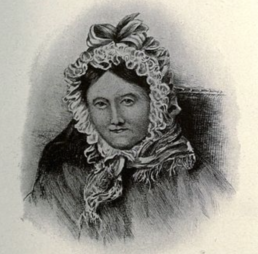These life stories may contain descriptions of childhood trauma and abuse, as well as images, voices and names of people now deceased. If you need help, you can find contact details for some relevant support services on our support page.
English diarist and poet, Dorothy Wordsworth (1771-1855), was in kinship care as a child.
Dorothy Mae Ann Wordsworth was born in Cockermouth, Cumberland, to lawyer John Wordsworth (1741-1783) and Ann Cookson (1747-1778). She was the only daughter in the family. She had two older brothers, Richard (b. 1768) and William (b. 1770) – the poet – and two younger ones, John (b. 1772) and Christopher (b. 1774).
Dorothy’s mother died in 1778 when the girl was not yet seven years old. Her father John split up his family, keeping the older boys, Richard and William, with him, and sending the younger ones, John and Christopher, to live with the maternal Cookson grandparents in Penrith, 50 km away.
Dorothy was sent to live with her mother’s cousin, Elizabeth Threlkeld, in Halifax. According to Robert Gittings and Jo Manton, as she lay dying, Ann had begged her thirty-three-year-old cousin to take in Dorothy.
Dorothy was happy in her new home and became part of a large extended family. Elizabeth Threlkeld was already caring for her older sister’s five children and she took over her brother-in-law’s haberdasher’s business when he died. Across the road was little Jane Pollard, the same age as Dorothy, and the two girls became lifelong friends.
Dorothy was sent to boarding school just out of Halifax at the age of nine. She was only there for three years. Her father died intestate with only a small personal estate at the end of 1783 and to save money, the children’s guardians—paternal uncle Richard Wordsworth and maternal uncle Christopher Cookson—withdrew Dorothy from the school.
The education of her four brothers was the priority as they were expected to go into professions; no professional work then existed for middle-class women.
Dorothy was happy enough back living with her ‘aunt’ and attending a local school until 1787 when she was sent to live with her maternal Cookson grandparents in Penrith. The sixteen-year-old was expected to ‘earn her keep’ by attending to household duties. Instead of leisure and education, life was now constant work and homesickness.
The benefit of living with her grandparents, however, was in finally connecting with the brothers she had not seen since she was despatched to Halifax in 1778. Particularly William, Christopher and John she came to know well and the four came to realise the impact of being without their parents.
Dorothy’s uncle William Cookson took the girl under his wing while home from Cambridge and continued with her education. In 1788 when William married another Dorothy, Dorothy Cowper, she moved in with the couple at the Forncett St Peter rectory, a parish in Norfolk. Dorothy lived happily with her uncle and his wife for six years. She helped in the household and with the children, but also began imagining how she would set up house with her brothers, especially William.
It was not until 1795, by which time Dorothy was in her early twenties before she and William began living together, first at Racedown Lodge in Dorset and later in Dove Cottage at Grasmere in the Lake District from 1799 to 1808. William married Mary Hutchinson in 1802, and the household at Dove Cottage quickly expanded with the birth of children.
Dorothy Wordsworth was a resourceful and practical odd-job woman, unafraid of work with her hands; indeed labour formed part of her romantic ideal of country life…Hemming curtains, sheets, towels, and table-cloths by hand was a matter of course…(Gittings & Manton, 113).
Dorothy continued living with William and Mary for the rest of her life, an important fixture in the household. With Mary, she ran the household, cared for children, hosted a constant stream of guests, wrote up William’s poetry, wrote poetry herself, and kept a journal. During the final two decades of her life, Dorothy was often unwell.
Dorothy never wrote for publication, but what’s known as her Grasmere Journals was published in 1897. The journal, which came to light as more attention was being paid to women’s literature, described her daily life in the Lake District. The two and half years covered by her Grasmere Journals would earn Dorothy Wordsworth the reputation of being “probably the most remarkable and the most distinguished of English prose writers who never wrote a line for the general public” (Selincourt cited by Wilson, 5).
Dorothy Wordsworth is now recognised as one of England’s ‘finest nature writers’. Well known, too, is that:
… her phrases and descriptions were lifted and used by both [William] Wordsworth and [Samuel Taylor] Coleridge, and that scholars refer to her for background material on her brother’s most creative period…(Wilson, 5).
References:
Gittings, Robert & Manton, Jo. Dorothy Wordsworth. Oxford: Clarendon Press, 1985.
Wilson, Frances. The Ballad of Dorothy Wordsworth. London: Faber & Faber., 2008.
Image available here.
